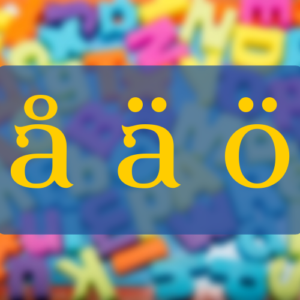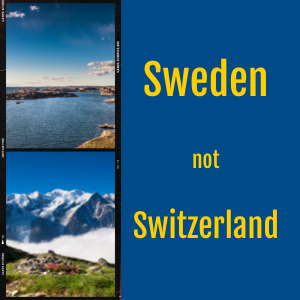The Swedish Language

Swedish (Svenska) is an East Scandinavian language spoken in Sweden, parts of Finland, and the autonomous Aland Islands. It is the most widespread Scandinavian language.
With only 10.5 million speakers, Swedish is a small language compared to English and other prominent languages. This isn’t surprising because a unified version was formed less than 1,000 years ago.
The languages spoken nowadays in Scandinavia developed from the Old Norse language, which was pretty much the same in present-day Denmark, Norway, and Sweden.
Standard Swedish (called in Swedish rikssvenska or, sometimes, “high” — högsvenska) is the most popular Swedish variety, developed from the dialects of Stockholm and its surroundings. It is a language of mass media (however, newsmen often speak with a strong regional accent), taught in schools, and understood by most Swedes. However, some Swedish dialects may differ so much in terms of pronunciation and grammar that they are not intelligible to foreigners.
The Swedish alphabet is Latin-based, including the letters Å, Ä, and Ö (listed in such order after the letter Z in the alphabet), as well as É. Before 2006, the letter W was not considered a separate letter but an equivalent of the V, and was used only in foreign names and loan words. In 2006, the letter W was added to the alphabet. Written Swedish is unified and standardized despite the wide range of dialects and varieties.
Swedish Vowels

There are nine vowels in Swedish. Each one has two different ways to pronounce it: long or short. Vowels are short before a long consonant (two or more consonants together). And vowels are long before a short consonant (one consonant), before another vowel, or at the end of a word.
A: long like father, short like must
Å: like home, without the glide
Ä: long like air, short like get
E: long like plane, short like get
I: long like meet, short like bit
O: long like food, short like good
Ö: long like the German shön, short like the French le
U: long like food, short like ultra
Y: long like “eey”, short like “ey”
Swedish Consonants
There are 20 consonants in the Swedish language. Although most of them are the same as English, you need to know a few important pronunciation differences.
C = “s” before e, i, and y. Everywhere else C = “k”
G is always hard like get, never soft like gem. Before e, i, y, ä, or ö G = “y” (like yes)
D, T, N are all pronounced with your tongue pressed against your top teeth
J = “y” (like yes)
K = “sh” before e, i, y, ä, ö. Before a, o, å, u, K = “k” (like kind)
R is rolled, like in Spanish
S = “s”, it’s never “z” like in has
The word order in Standard Swedish is similar to other Germanic languages. Meaning the finite verb always appears in the second position. Morphologically, standard Swedish is quite similar to English. This entails that words have lost their inflections, apart from a few exceptions. But unlike English, Swedish has feminine and masculine genders.
Just like in English, adjectives are compared similarly but are inflected depending on the definiteness, number, and gender. Unlike English, the definiteness of the nouns is marked not through articles but suffixes. Then, it is complemented with separated indefinite and definite articles.
Swedish Dialects
Swedish is traditionally divided into six major dialect groups: Norrland, Svealand, Gotland, Götaland, South Swedish, and East Swedish (Finland Swedish). The actual number of dialects is several hundred, though most are more or less mutually intelligible, except for some highly diverging forms found in Dalarna, Norrbotten, and Gotland
It’s interesting to note that some Swedish dialects sound nearly incomprehensible to those who speak Standard Swedish. This means you can visit a town in Sweden and not understand a word they are saying despite being fluent in standard Swedish.
Swedish dialects are composed of six different categories. This includes South Swedish, Norrland, Finland Swedish, Gotland, Götamal, and Svealand.
I have included some sound samples here; they all come from this website http://swedia.ling.gu.se/
South Swedish

South Swedish is one of the major Swedish dialects. It includes closely related dialects that used to be spoken in Scania, Halland, Smaland, and Blekinge, which all used to be part of Denmark, but became part of Sweden in 1958. The phonology of this dialect is heavily influenced by Danish, especially considering the use of uvular trills instead of alveolar trills, as well as the softening of some consonants.
Norrland

This is a Swedish dialect that covers most of Norrland. However, it doesn’t cover southern Halsingland and Gastrikland, where the Svealand Swedish is spoken. The parishes in the Medieval days played a role in the division of this dialect.
Similar to other Swedish dialects, it is challenging to define the linguistic traits of this dialect, just as it’s difficult to split this geographically into other subdialects. For the Norrland dialect, the syllables usually have a long vowel sound and a consonant or a short vowel sound followed by a long consonant. Some words also have an “SJ sound” that is pronounced with the tip of the tongue against the alveolar ridge, which is located between the hard palate and the upper front teeth.
Finland Swedish

This is one of the major Swedish dialects spoken outside Sweden. It’s impressive that a country with a small population, like Finland, has a lot of Swedish speakers.
Like other dialects, there are major differences between Finland Swedish and standard Swedish. Some words are used in different contexts and may have a different meanings altogether. There are also words in Finland Swedish that are not present in standard Swedish. Some archaic words have also changed their meaning but are continued to be used.
If a standard Swedish speaker listens to people speaking Finland Swedish, the order of words may sound weird. While it is still technically correct, there is no denying that it is strange to the ears of traditional Swedish speakers.
Finland Swedish also lacks intonation and melody, and this is important to note because standard Swedish has retained tonal characteristics. Because of this, standard Swedish speakers assume that Finnish Swedish is simply the normal language spoken with a Finnish accent, which is wrong.
Gotland

Gotland is one of the Swedish dialects which stemmed from Old Gutnish. Some of the notable features of this dialect include the preservation of diphthongs like “ai” and “oy.” There is also the triphthong “iau” in this dialect that is unique in Norse languages.
This dialect is still under the heavy influence of the Swedish standard language. But because of the location where the dialect is spoken, there are influences from German and Danish.
Götaland

This Swedish dialect is mostly spoken in northern Småland, northern Halland, Dalsland, Östergötland, Värmland, and Bohusiän. Examples of Götamal features are vowel shortening in front of endings and the loss of “r” in suffixes. This dialect also has vowel reduction.
Svealand

This is one of the Swedish dialects that clearly distinguishes it from Finnish Swedish. One factor that makes Svealand Swedish unique is its coalescence of alveolar trill, following alveolar and dental consonants.
New YouTube Channel – Swedish For Fun
For those interested in learning a word or two in Swedish, I have started a new YouTube channel called Swedish for fun.




